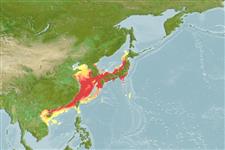Environment: milieu / climate zone / depth range / distribution range
экология
морской демерсальный; пределы глубины 2 - 170 m (Ref. 56557), usually 100 - ? m (Ref. 84246). Temperate
Northwest Pacific: offshore waters around Japan, Korea, China, Taiwan and southern East China Sea.
Size / Вес / Возраст
Maturity: Lm ? range ? - ? cm
Max length : 30.0 cm SL самец/пол неопределен; (Ref. 559); наибольший вес (опубликованные данные): 1.0 kg (Ref. 56557)
Краткое описание
определительные ключи | морфология | морфометрия
членистые (мягкие) лучи спинного плавника (общее число) : 67 - 81; членистые (мягкие) лучи анального плавника: 48 - 58; позвонки: 35 - 37. This species is distinguished by the following characters: scale length (from trunk area) is greater than 1.33% of SL, the whole scale outline oval, exposed margin rounded; scales highly deciduous, longitudinal rows occasionally irregular; upper eye area usually greater than that of lower eye, area ratio 0.93–1.44; central longitudinal scales 75-87, scales below lateral line 47-57; abdominal vertebrae 12-13 (mostly 12) (126213).
Inhabits sandy and muddy bottoms in coastal areas (Ref. 9137, 11230); but mainly muddy bottoms in offshore deeper (from ca. 40m) waters, possibly due to its highly deciduous scales, it may avoid sandy bottoms. It occurs in lower densities than P. lighti in shallower coastal waters, including the Seto Inland Sea (Ref. 126213). Recorded from several depth ranges from the following localities: 40-60 m off Soma, Fukushima Prefecture; 40-75 m in Kii Channel; ca. 140-150 m off Hamada, Shimane Prefecture; ca. 60 m in Seto Inland Sea; and, 76-143 m in East China Sea. It was also reported from 30 to 140 m in the Kii Channel, being especially numerous from deeper than 100 m (Ref. 84246). The flesh of this species is soft, and the quality declining quickly after death, that the species has a low market value (Ref. 126213).
Life cycle and mating behavior
половая зрелость | размножение | нерест | икра | Fecundity | личинки
Vinnikov, K.A., R.C. Thomson and T.A. Munroe, 2018. Revised classification of the righteye flounders (Teleostei: Pleuronectidae) based on multilocus phylogeny with complete taxon sampling. Molecular phylogenetics and evolution, 125:147-162. (Ref. 122998)
Статус Красного Списка МСОП (Ref. 130435: Version 2024-2)
Угроза для людей
Harmless
Использование человеком
рыболовство: коммерческий
дополнительная информация
инструменты
Специальные отчеты
Скачать в формате XML
ресурсы в Интернет
Estimates based on models
Preferred temperature (Ref.
123201): 13.9 - 25.2, mean 20.7 °C (based on 278 cells).
Phylogenetic diversity index (Ref.
82804): PD
50 = 0.5078 [Uniqueness, from 0.5 = low to 2.0 = high].
Bayesian length-weight: a=0.01479 (0.01036 - 0.02113), b=3.00 (2.90 - 3.10), in cm total length, based on LWR estimates for this species (Ref.
93245).
Trophic level (Ref.
69278): 3.2 ±0.3 se; based on size and trophs of closest relatives
устойчивость к внешним воздействиям (Ref.
120179): средний (среднего размера), минимальное время удвоения популяции 1.4-4.4 года (K=0.18).
Fishing Vulnerability (Ref.
59153): Moderate vulnerability (39 of 100).
